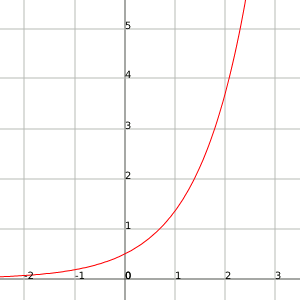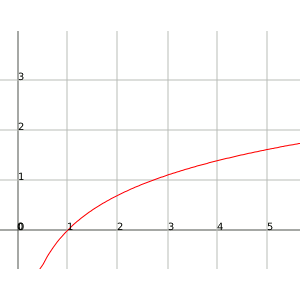Finite limits
We will start by showing a small summary of the properties of finite limits.
Let's suppose that $$\displaystyle\lim_{x \to \pm \infty}{f(x)}=a$$ and that $$\displaystyle\lim_{x \to \pm \infty}{g(x)}=b$$, then also:
- $$\displaystyle\lim_{x \to \pm \infty}{f(x) \pm g(x)}=\displaystyle\lim_{x \to \pm \infty}{f(x)} \pm \displaystyle\lim_{x \to \pm \infty}{g(x)}=a \pm b$$
- $$\displaystyle\lim_{x \to \cdot \infty}{f(x) \pm g(x)}=\displaystyle\lim_{x \to \pm \infty}{f(x)} \cdot \displaystyle\lim_{x \to \pm \infty}{g(x)}=a \cdot b$$
- If $$b \neq 0$$, $$\displaystyle\lim_{x \to \cdot \infty}{\frac{f(x)}{g(x)}}=\frac{\displaystyle\lim_{x \to \pm \infty}{f(x)}}{\displaystyle\lim_{x \to \pm \infty}{g(x)}}=\frac{a}{b}$$
- If $$f(x)>$$, $$\displaystyle\lim_{x \to \pm \infty}{f(x)^{g(x)}}=\displaystyle\lim_{x \to \pm \infty}{f(x)^{\displaystyle\lim_{x \to \pm \infty}{g(x)}}}=a^b$$
- If $$n$$ odd or if $$n$$ even and $$f(x)\geqslant0 \Rightarrow \displaystyle\lim_{x \to \pm \infty}{\sqrt[n]{f(x)}}=\sqrt[n]{\displaystyle\lim_{x \to \pm \infty}{f(x)}}=\sqrt[n]{a}$$
- If $$\alpha >0$$ and $$f(x)>0$$, $$\displaystyle\lim_{x \to \pm \infty}{ \log_{\alpha}f(x)}=\log_{\alpha}\Big(\displaystyle\lim_{x \to \pm \infty}{f(x)}\Big)=\log_{\alpha}a$$
If $$\displaystyle\lim_{x \to {+} \infty}{f(x)}=3$$ and $$\displaystyle\lim_{x \to {+} \infty}{g(x)}=-5$$ then:
- $$\displaystyle\lim_{x \to {+} \infty}{f(x)+g(x)}=3-5=-2$$
- $$\displaystyle\lim_{x \to {+} \infty}{f(x)-g(x)}=3-(-5)=8$$
- $$\displaystyle\lim_{x \to {+} \infty}{f(x) \cdot g(x)}=3 \cdot (-5)=-15$$
- $$\displaystyle\lim_{x \to {+} \infty}{f(x)^g(x)}=3^{-5}=\frac{1}{3^5}=\frac{1}{243}$$
- $$\displaystyle\lim_{x \to {+} \infty}{g(x)^{f(x)}}$$ does not exist since $$g(x) < 0$$ for $$x$$ large enough.
- $$\displaystyle\lim_{x \to {+} \infty}{\sqrt[3]{g(x)}}=\sqrt[3]{-5}=-\sqrt[3]{5}$$
- $$\displaystyle\lim_{x \to {+} \infty}{\sqrt{g(x)}}$$ does not exist since $$g(x) < 0$$ for $$x$$ large enough.
Infinite limits
Let's start by defining what an infinite limit of a function is $$f(x)$$:
$$$\displaystyle\lim_{x \to {+} \infty}{f(x)}=+\infty \Longleftrightarrow \mbox{ given any } k, \mbox{ there exists another number } h$$$
$$$ \mbox{ such that if } x>h \mbox{ then } f(x)>k$$$
Intuitively, it means that we can have $$f(x)$$ as big as we want by choosing a sufficiently large $$x$$.
Similarly, we define:
$$$\displaystyle\lim_{x \to {+} \infty}{f(x)}=-\infty \Longleftrightarrow \mbox{ given any } k, \mbox{ there exists another number } h$$$
$$$ \mbox{ such that if } x>h \mbox{ then } f(x)<-k$$$
and for limits when $$x$$ goes to minus infinity:
$$$\displaystyle\lim_{x \to {-} \infty}{f(x)}=+\infty \Longleftrightarrow \mbox{ given any } k, \mbox{ there exists a another number } h$$$
$$$\mbox{ such that if } x<-h \mbox{ then } f(x)>k$$$
$$$\displaystyle\lim_{x \to {-} \infty}{f(x)}=-\infty \Longleftrightarrow \mbox{ given any } k, \mbox{ there exists a another number } h $$$
$$$\mbox{ such that if } x<-h \mbox{ then } f(x)<-k$$$
Let's see three basic examples of functions that tend to infinity:
$$k$$th power: if $$k>0, \displaystyle\lim_{x \to {+}\infty}{x^k}=+\infty$$
and in particular $$\displaystyle\lim_{x \to {+}\infty}{p\cdot x^k}=sign(p) \cdot \infty$$ , where $$p$$ is a real value other zero.
From this point, we deduce that the polynomial functions tend to infinity as $$x$$ becomes larger.

In this example we can see the function $$f(x)=3x^4$$. When $$x$$ becomes large, the function grows to infinity.
Exponential: if $$a>1, \displaystyle\lim_{x \to {+}\infty}{a^x}=+\infty$$
and likewise if $$a>1, \displaystyle\lim_{x \to {+}\infty}{p \cdot a^x}=sign(p) \cdot \infty$$ .

An example for this case is the function $$f(x)=\dfrac{1}{2}e^x$$. It tends to infinity as $$x$$ tends to infinity.
Logarithmic: if $$a>1, \displaystyle\lim_{x \to {+}\infty}{\log_{a}x}=+ \infty$$
Similarly if $$a>1 \displaystyle\lim_{x \to {+}\infty}{\log_{a}x}=sign(p) \cdot \infty$$.

For example, the function $$f(x)= \log_{e}x=\ln x$$. This function tends to infinity as $$x$$ becomes very large.
Infinite's arithmetic
Let's suppose that $$\displaystyle\lim_{x \to {+} \infty}{f(x)}=+\infty$$ and that $$\displaystyle\lim_{x \to {+} \infty}{g(x)}=+\infty$$, then we observe without problems that:
$$$\displaystyle\lim_{x \to {+} \infty}{f(x)+g(x)}=\displaystyle\lim_{x \to {+} \infty}{f(x)}+\displaystyle\lim_{x \to {+} \infty}{g(x)}=+\infty + \infty=+\infty$$$
$$$\displaystyle\lim_{x \to {+} \infty}{f(x) \cdot g(x)}=\displaystyle\lim_{x \to {+} \infty}{f(x)} \cdot \displaystyle\lim_{x \to {+} \infty}{g(x)}=(+\infty) \cdot (+\infty)=+\infty$$$
However, we will have problems when we encounter situations like the following one:
$$$\displaystyle\lim_{x \to {+} \infty}{f(x)-g(x)}=\displaystyle\lim_{x \to {+} \infty}{f(x)}-\displaystyle\lim_{x \to {+} \infty}{g(x)}=(+\infty)-(+\infty)$$$
since to if we subtract infinity from infinity it gives us an indeterminacy.
Similarly, we might ask ourselves about these properties when we a function with an infinite limit and one with a finite limit.
Let's see a small table that will show us how to work when we have different kinds necessary to produce infinity with other infinites and with finite limits:
| SUMS | PRODUCTS |
| $$(+\infty)+a=+\infty$$ | $$(+\infty)\cdot(+\infty)=+\infty$$ |
| $$(+\infty)+(+\infty)=+\infty$$ | $$(+\infty)\cdot(-\infty)=-\infty$$ |
| $$(-\infty)+a=-\infty$$ | $$(+\infty)\cdot a=sign(a) \cdot \infty$$ |
| $$(-\infty)+(-\infty)=-\infty$$ | $$(-\infty)\cdot a=-sign(a) \cdot \infty$$ |
| $$-(-\infty)=+\infty$$ | |
| DIVISIONS | POWERS |
| $$\frac{a}{\pm \infty}=0$$ | $$(+\infty)^{+\infty}=+\infty$$ |
| $$\frac{a}{0}=\pm \infty$$ if $$a\neq 0$$ | $$(+\infty)^{-\infty}=0$$ |
| $$\frac{\pm \infty}{0}=\pm \infty$$ | if $$a$$ > $$0$$ $$$(+\infty)^a= + \infty$$$ |
| $$\frac{0}{\pm \infty}=0$$ | if $$a$$ < $$0$$ $$$(+\infty)^a=0$$$ |
| if $$a\neq 0$$ $$$a^0=1$$$ | |
| if $$a$$ > $$1$$ $$$a^{+\infty}=+\infty \\ a^{-\infty}=0$$$ | |
| if $$0$$ <$$a$$ < $$1$$ $$$a^{+\infty}=0 \\ a^{-\infty}=+ \infty$$$ |
These operations can be realized after finding the limits of the functions involved.
Nevertheless, the operations that are not in the table can produce indeterminacies, for example, the following expressions:
$$$(+\infty)-(+\infty) \\ 0 \cdot (\pm \infty) \\ \frac{0}{0} \\ (+\infty)^0 \\ 1^{\pm \infty} \\ 0^0 \\ \frac{\pm \infty}{\pm \infty}$$$
